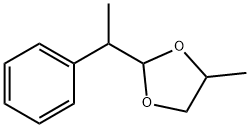1,3-DIOXOLANE, 2-(1-PHENYLETHYL)
- CAS NO.:4362-22-5
- Empirical Formula: C11H14O2
- Molecular Weight: 178.23
- MDL number: MFCD00082223
- EINECS: 224-449-9
- SAFETY DATA SHEET (SDS)
- Update Date: 2024-12-18 14:15:30

What is 1,3-DIOXOLANE, 2-(1-PHENYLETHYL)?
Chemical properties
Slightly bitter, Mushroom-like, but not exactly pleasant taste. This Acctal is one of the most commonly used of the cyclic Acctals of Hydratropaldchyde. In spite of its very peculiar odor, it finds application in a great variety of fragrances and - because of its lack of sweetness - not much in flavor compositions.
The Uses of 1,3-DIOXOLANE, 2-(1-PHENYLETHYL)
Chyprc, Fougerc and other Oakmoss-carrying fragrances can achieve intriguing nuances with this material, and woody bases can be modified into new types. Coumarin and its derivatives arc good sccondaty fixatives, and Opopanax is often a very interesting companion to this Acetal.
Definition
ChEBI: A dioxolane that is 1,3-dioxolane substituted by a 1-phenylethyl group at position 2.
Synthesis
2-(1-phenylethyl)-1,3-dioxolane is produced by condensation of Hydratropaldchyde with Ethylene glycol.
Properties of 1,3-DIOXOLANE, 2-(1-PHENYLETHYL)
| solubility | Almost insoluble in water, soluble in alcohol and oils. |
| color | Colorless oily liquid |
| Odor | at 100.00 %. floral green mushroom earth |
| EPA Substance Registry System | 1,3-Dioxolane, 2-(1-phenylethyl)- (4362-22-5) |
Safety information for 1,3-DIOXOLANE, 2-(1-PHENYLETHYL)
Computed Descriptors for 1,3-DIOXOLANE, 2-(1-PHENYLETHYL)
New Products
(S)-3-Aminobutanenitrile hydrochloride 4-Methylphenylacetic acid N-Boc-D-alaninol N-BOC-D/L-ALANINOL Tert-butyl bis(2-chloroethyl)carbamate 3-Morpholino-1-(4-nitrophenyl)-5,6-dihydropyridin- 2(1H)-one Furan-2,5-Dicarboxylic Acid Tropic acid 1-Bromo-3,5-Di-Tert-Butylbenzene S-2-CHLORO PROPIONIC ACID ETHYL ISOCYANOACETATE 2-Bromo-1,3-Bis(Dimethylamino)Trimethinium Hexafluorophosphate 4-IODO BENZOIC ACID 3-NITRO-2-METHYL ANILINE 1-(2,4-DICHLOROPHENYL) ETHANAMINE (2-Hydroxyphenyl)acetonitrile 4-Bromopyrazole 2-(Cyanocyclohexyl)acetic acid 4-methoxy-3,5-dinitropyridine 1-(4-(aminomethyl)benzyl)urea hydrochloride 2-aminopropyl benzoate hydrochloride diethyl 2-(2-((tertbutoxycarbonyl)amino) ethyl)malonate tert-butyl 4- (ureidomethyl)benzylcarbamate Ethyl-2-chloro((4-methoxyphenyl)hydrazono)acetateRelated products of tetrahydrofuran








You may like
-
 2033-24-1 98%View Details
2033-24-1 98%View Details
2033-24-1 -
 42831-50-5 5-METHYLISOXAZOLE-4-CARBOXYLIC ACID 98%View Details
42831-50-5 5-METHYLISOXAZOLE-4-CARBOXYLIC ACID 98%View Details
42831-50-5 -
 1975-50-4 98%View Details
1975-50-4 98%View Details
1975-50-4 -
 2-HYDROXY BENZYL ALCOHOL 98%View Details
2-HYDROXY BENZYL ALCOHOL 98%View Details
90-01-7 -
 2-Chloro-1,3-Bis(Dimethylamino)Trimethinium Hexafluorophosphate 221615-75-4 98%View Details
2-Chloro-1,3-Bis(Dimethylamino)Trimethinium Hexafluorophosphate 221615-75-4 98%View Details
221615-75-4 -
 61397-56-6 CIS BROMO BENZOATE 98%View Details
61397-56-6 CIS BROMO BENZOATE 98%View Details
61397-56-6 -
 14714-50-2 (2-Hydroxyphenyl)acetonitrile 98+View Details
14714-50-2 (2-Hydroxyphenyl)acetonitrile 98+View Details
14714-50-2 -
 118753-70-1 98+View Details
118753-70-1 98+View Details
118753-70-1